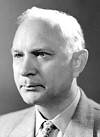
Internationally, Bartels served as first President of the newly-narned IAGA from 1954 to 1957, and as Vice-President of IUGG from 1960 to 1963. But for his untimely death he would, by common consent, almost certainly have become President of IUGG. He was awarded the Charles Chree Medal and Prize of the Physical Society (London) in 1953, the Emil Wiechert Medal of the German Geophysical Society in 1955, and the Bowie Medal of the American Geophysical Union (posthumously) in 1964. As head of the German National Committee for the International Geophysical Year he took a leading part in planning the German IGY programme and, together with Chapman, was much involved in the organization of the IGY internationally. He also served as Vice-President of the German Commission for Space Research and was President and co-founder of the Gauss Society of Göttingen (recognizing another outstanding Göttingen scientist).
As an author, Bartels is probably best know for his coauthorship of the masterly two-volume work entitled Geomagnetism, published by the Oxford University Press in 1940 and dedicated to Adolf Schmidt. This thousand-page book, profusely illustrated and referenced, proved to be the definitive reference work for a generation of students, to whom it was always known as "Chapman and Bartels". Its appeal stretched far beyond the confines of geomagnetic studies themselves, containing as it did extensive review articles on related topics in meteorology, solar and lunar physics, the aurora, and (thanks, especially to Bartels) the techniques of spherical harmonic analysis and treatment of periodicities in geophysical data generally. Bartels was probably the first to see clearly that conventional statistical tests of significance for apparent periodicities would be misleading when applied to geophysical data unless account was taken of the so-called "persistence" or "conservation" inherent in the data. He developed rigorous statistical procedures which allowed distinction to be made between random, periodic, and quasi-periodic variations. These he applied fruitfully to many problems in geophysics, including the periodic effects of the Moon's gravitational and the Sun's thermal and gravitational influences on atmospheric tides and their consequent influences on geomagnetic and ionospheric variations.
Bartels' investigations led to a clear distinction between geomagnetic variations arising from wave and particle radiation from the Sun and he developed measures of solar wave radiation based on the geomagnetic diurnal variation. He improved or developed indices of magnetic disturbance, including the famous three-hourly planetary Kp index (prepared through his auspices since 1932) and its associated Ap and Cp as indicators of solar particle radiation. His gift for graphical presentation is illustrated in his wellknown "musical scales" of Kp which he used to investigate 27-day variations in geomagnetic activity linked to the solar rotation period, first discovered by Chree. From his studies of these variations, which were sometimes evident when there were no visible spots on the Sun, he postulated the existence of so-called "M regions" (M for magnetically active), discovered first by Maunders which emitted particle radiation without any visible footprint on the solar surface. It was some decades later that the true nature of M regions, and their association with coronal holes, was understood. To summarize, Bartels was one of those rare scientists who, like his associate Sydney Chapman, contributed significantly to almost the whole range of the contemporary solarterrestrial physics discipline: solar and lunar physics, geomagnetism, meteorology, acronomy and ionospheric physics, plus fundamental work on statistical methods as applied to geophysical data.